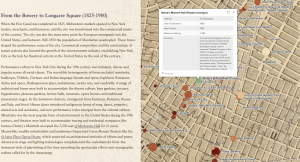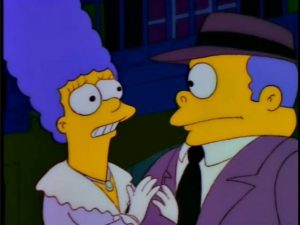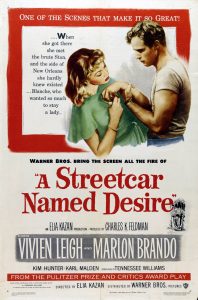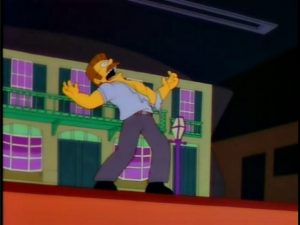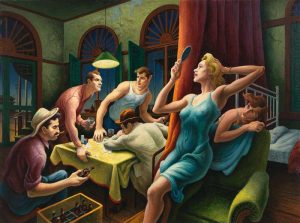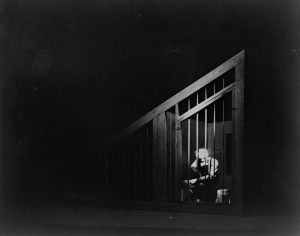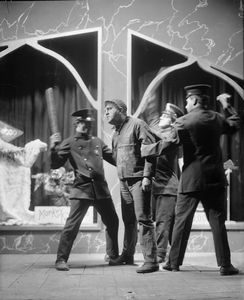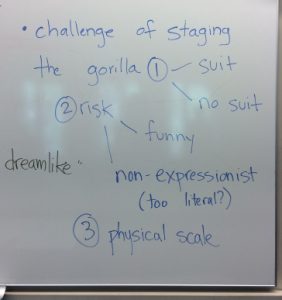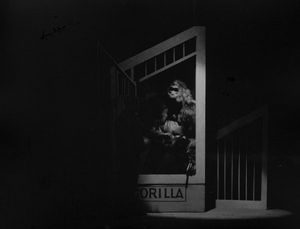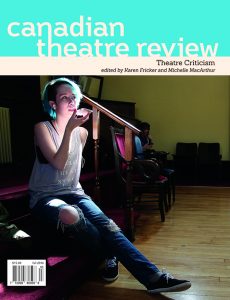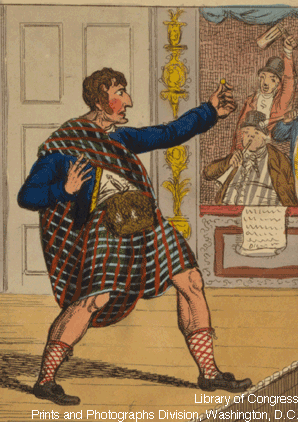My first reference to Hamilton in the classroom occurred in Fall 2015. I had recently seen the CBS Sunday Morning piece on the musical and viewed it as an opportunity to discuss casting in my Introduction to Theatre course.[1] Since then, I have incorporated Hamilton into the classroom to varying degrees and in various ways to engage students in a variety of topics.[2] I offer here a description of ways I have integrated Hamilton into my curriculum, and reflect on the effectiveness of such incorporation.
For context, I think it important to share a bit about the campus community at California Polytechnic State University (Cal Poly), and the theatre studies courses I teach there, including Introduction to Theatre, Theatre History, and Honors Program Seminars. Majors and non-majors comprise all of my classes, with non-majors usually filling 75-80% of the seats. Typically, I have around fifty students in both my Intro and Theatre History courses, as they each fulfill a general education requirement on campus. One of the challenges I face, then, is teaching to multiple levels of engagement, interest, and experience. It’s not uncommon for me to teach an upper-level subtopics course to juniors and seniors, some of whom are majors and many of whom have never read a play. Furthermore, Cal Poly’s student population is overwhelmingly white: 56% of the students identify as white, with Hispanic/Latinx students making up the second largest population at 16%. African-American, Native American, and Pacific Islander students each make up less than 1% of the student population. Ergo, the lessons about storytelling and representation that Hamilton can provide and the discussions it can initiate are both valuable and crucial.[3]
One reason I have found Hamilton effective is because both my majors and non-majors quickly engage with the show. While few students have actually seen it, most are at least nominally familiar with the musical at this point. Generally, once I introduce Hamilton to students (often with the CBS Sunday Morning piece), they are hooked. This interest has afforded me opportunities to use the show to explain various performance topics, create group assignments based on the production, and even build an entire seminar around it.
In terms of using Hamilton to explore particular topics, I have found it most effective in discussing casting and historiography. In Intro, I show interviews and clips from Hamilton in order to introduce discussion of different views on and approaches to casting, including “blind” casting, cross-casting, color-conscious casting, and coalitional casting. I also have students read various responses to the casting choices in Hamilton, including reactions to the controversy that emerged last spring when a casting notice for the touring company called for non-white actors.[4] Using Hamilton in these discussions opens up considerations of a multitude of issues surrounding casting including representation, opportunity, authorial intent, and storytelling. Through small group discussion (which typically leads to a conversation by the entire class), students wrestle with approaches and reactions to casting, and begin to realize the complexities involved. I have found that Hamilton raises awareness of not only the complexities, but also the stakes involved in casting. I often share a quote from Okieriete Onaadowan, who played Hercules Mulligan/James Madison: He doesn’t want to do “another show about a messed up black kid,” and instead, in Hamilton, is “a black man playing a wise, smart, distinguished future president.”[5]
With regard to historiography, I have found that Hamilton helps students understand (at least basically) looking at the past through a historiographic lens. Notably, the songs “History Has Its Eyes on You,” and “Who Lives, Who Dies, Who Tells Your Story?,” in addition to the repeated motif of legacy in the show, encourage students to think about the construction and dissemination of (hi)stories. Ron Chernow, who wrote the biography upon which the musical is based, has noted the “historiographical rigor” of the show.[6] After completing a project on Hamilton for Theatre History II last spring, one student explained during her presentation that she had a discovery about historiography while working on the assignment.[7] She explained that she is from the American South and that she did not recollect discussing Alexander Hamilton in history classes during her upbringing. She claimed that she asked her mother, who is a teacher and owns several textbooks from the student’s youth to search for Hamilton in the textbooks, only for the search to come up empty. The student suggested that Hamilton’s absence from her textbooks may be related to the unfavorable view of Hamilton in the South. She then told her fellow students that it’s important to pay attention to how a historian’s own embedded biases and background may inform the historical narratives she/he creates.[8]
During the aforementioned Theatre History II course, I developed a group project in which a group of six students analyzed Hamilton.[9] I listed the following as expectations for the students:
- Listen to the Hamilton
- Read the libretto/book included with the soundtrack.
- Conduct individual and group research on the musical.
- Analyze 3 songs within the production.
- Respond to discourse surrounding the musical.
- Present findings/discoveries/thoughts to class.
I provided a set of questions and prompts to help guide their research and analysis. In addition to background information on the show and its creation, the assignment required students to find images, video clips, and sound clips from the show. Students analyzed a total of three songs from the show; they had to include “Who Lives, Who Dies, Who tells Your Story?” as one of their songs. The students also responded to four articles about the show, two of which were positive reactions and two of which included critique of the musical. Finally, I asked students to reflect upon notions of historicization and how the musical uses the past to comment on our world today. I explained to the group that it was important that the students meet as a group and discuss their research and analysis (rather than exchanging ideas solely through a Google Doc). To conclude the project, the group presented their research and discoveries with the class.
Though group presentations can consume a lot of precious class time, I found that the value of this group’s presentation was worth it. The students’ enthusiasm for the topic and the “a-ha moments” they experienced while completing the assignment was palpable. One group member shared that he had bought Chernow’s biography and was already halfway through reading it, even though he was not required to do so. Not only did the group’s classmates ask follow-up questions, but many also inquired about the show at my office hours after the presentation. Several group members later recommended that I continue to assign the project to the entire class, rather than just one group.
The level of engagement demonstrated by the students in Theatre History II inspired me to create opportunities for deeper exploration into Hamilton for students. The possibility for a more in-depth engagement arose this past fall when I taught an Honors Seminar. The class met weekly for 50-minutes, and was developed as a supplement to Intro to Theatre. Fourteen students comprised the seminar, with twelve also enrolled in my section of Intro that quarter, and two enrolled in another instructor’s section of the course. The purpose of the seminar was to provide deeper exploration into the concepts taught in Intro to Theatre. The format of the weekly meetings was primarily discussion-based. Though I was unsure of the sustainability of Hamilton as the sole case study for the seminar, I proceeded to shape the 10-week course around the musical.
For required texts, I assigned the musical soundtrack, as well as the book, Hamilton: The Revolution by Lin-Manuel Miranda and Jeremy McCarter. I hesitated to require the book, but found it to be a valuable supplement to not only the seminar, but to the textbook I had assigned in my Intro class.[10] Relatively inexpensive at $35, Hamilton: The Revolution chronicles the development of the musical from inception to opening night on Broadway. McCarter relies heavily on interviews with those involved in the show’s creation and fills the text’s pages with behind-the-scenes photographs, costume and set renderings, scanned pages from Miranda’s notebooks, and production images. The book also features the lyrics to each song, with footnotes by Miranda revealing inspirations, anecdotes, and other informative commentary on the show’s libretto.
In preparation for each week’s meeting, students read several chapters from the book and contributed to an online discussion board by identifying a “Quotable Lyric.” This quotable lyric need not be the students’ “favorite” lyric, rather one that particularly struck them. Students also explained why they chose that lyric. During the first few weeks, the online board served as a repository for favorite lyrics, but later became a trove of connections that students made between the seminar and the concurrent Intro class, as well as between Miranda’s oft-poignant wordplay and the issues emerging in the political landscape that dominated the months leading up to the election.
Initially, rather than assigning the book chapters in chronological order, I tried to lay out the assigned readings in such a way to reflect what we were covering in Intro that week. For instance, I asked students to jump to Chapter XIV, “On Paul Tazewell and the Fashion of the Revolution” the same week we covered costume design in Intro to Theatre. A couple weeks in, however, I shifted the reading schedule so that the students read the book in chronological order. Because the book tracks the creation of the musical through its run at The Public to the Broadway premiere, I felt it was more important for students to trace the stages of development many shows undergo. Luckily, the students were able to recall the concepts we discussed in Intro weeks later in the seminar. In many ways, I believe that encountering the concepts at different intervals during the quarter helped to reinforce the ideas for the students. For instance, when we finally read Chapter XIV, students applied considerations of material, line, and metaphor they had encountered earlier in the quarter in Intro to Theatre.
Most of my students remarked in their student evaluations that they enjoyed reading Hamilton: The Revolution and appreciated that it lined up well with the material covered in Intro. An accessible read, the book offers valuable insights to the show and theatre. It initiated conversations on wide-ranging performance topics such as copyrights, understudies, finances, choreography, space, and sound mixing and design. Students also pointed out that the book, through Miranda’s input, provided studies in music history and genre. This led to a scavenger hunt assignment, through which students looked up the musical theatre, rap, and hip-hop influences Miranda cites in his footnotes.[11] The scavenger hunt also sent students on a search for examples of Alexander Hamilton’s writing. I designed this assignment to set the groundwork for their next project; a group presentation to my section of Intro to Theatre.
The Honors Seminar group presented some of their reflections and discoveries to the Intro class during the musical theatre unit. To do so, they divided into groups of 3-4 and each group covered a particular facet of Hamilton. I left it up to the students to decide what topics to include (this provided a great opportunity for students to practice the type of selection process that we as teachers, historians, scholars, and artists continually face). They decided to focus on background, choreography, musical references, design, casting, and historiography.[12] As was the case in Theatre History II, the group’s investment in the delivery of their work piqued their classmates’ interest.
Concerned that the seminar students had become a bit too effusive in their obsession with Hamilton, at the end of the quarter I assigned them two readings that offer some critique of Hamilton: James McMaster’s “Why Hamilton is Not the Revolution You Think It Is” and Stacey Wolf’s response to the show on The Feminist Spectator.[13] Both of these responses allowed the class to take a step back and discuss the merit in McMaster’s and Wolf’s points, as well as the importance in being able to critically reflect upon even the things we love, rather than blindly adoring them.
From verbal feedback and quantitative evaluation data I have received from seminar students, it seems using Hamilton as the sole case study for the course worked well. Other honors students have inquired as to when I will be teaching the “Hamilton class” again. I am not sure what future curricular “revolutions” Hamilton will inspire in my classrooms. In my experience, however, Hamilton provides a theatrical example that is exciting, entertaining, and engaging to students, both majors and non-majors.
Click here for Deconstructing Hamilton Guidelines and Hamilton Scavenger Hunt prompt.
[1] Since fall 2015, I have shown the CBS Sunday Morning report in several classes. I have found that it is a great introduction to the musical for students who are not familiar with the show. (https://www.youtube.com/watch?v=0wboCdgzLHg)
[2] Obviously, I do not shape and wield words with the same talent that Lin-Manuel Miranda possesses, but one of the elements that students enjoy discussing is the wordplay used by Miranda. My play with variation/various/variety here is a nod to Miranda’s exploration of words and language in Hamilton. I have found that students (especially English majors) enjoy analyzing this aspect of the show, and often, in their responses, began to experiment with their own use of language.
[3] This is not to suggest that these discussions are any less valuable and crucial at institutions with more diversity.
[4] Here are a few of many responses (I find these especially useful): https://www.theatlantic.com/entertainment/archive/2016/03/hamilton-casting/476247/;
http://www.americantheatre.org/2016/01/07/standing-up-for-playwrights-and-against-colorblind-casting/; http://www.broadwayworld.com/article/HAMILTONs-Lin-Manuel-Miranda-Speaks-On-Race-and-Casting-20151203#
[5] Lin-Manuel Miranda and Jeremy McCarter, Hamilton: The Revolution (New York: Grand Central Publishing, 2016) 149.
[6] Miranda and McCarter 125.
[7] I will explain the nature of the project later in this piece.
[8] Admittedly, this was a bittersweet moment for me; sweet because I was excited this student was able to articulate this to her peers and bitter because Hamilton was able initiate the comprehension I had been trying to achieve all quarter.
[9] Please see Assignment Guidelines for more details.
[10] I currently assign Mira Felner’s Think Theatre in my Introduction to Theatre classes.
[11] Please see Scavenger Hunt. The newly-release Hamilton Mixtape can provide further investigation of Miranda’s musical influences and ideas not found in the show, including “Immigrants (We Get the Job Done),” recorded by immigrants and children of immigrants. Miranda also includes “Cabinet Battle #3” on Mixtape, an example of a track that was cut during the process of shaping the show. In the book, Miranda expresses his difficulty in letting go of this battle about slavery, which provides a valuable lesson to students about the editing process and selecting the components that make it to the final (hi)story.
[12] I promise I did not insist on that last topic. (Though I was glad they chose to include it.)
[13] http://howlround.com/why-hamilton-is-not-the-revolution-you-think-it-is; https://feministspectator.princeton.edu/2016/02/24/hamilton/
